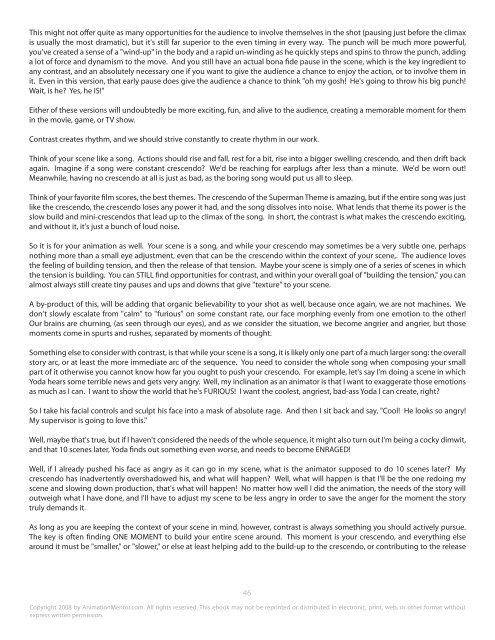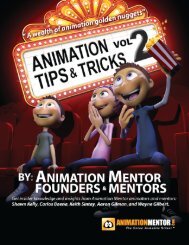Animation Tips & Tricks, Volume I - Animation Mentor
Animation Tips & Tricks, Volume I - Animation Mentor
Animation Tips & Tricks, Volume I - Animation Mentor
You also want an ePaper? Increase the reach of your titles
YUMPU automatically turns print PDFs into web optimized ePapers that Google loves.
This might not offer quite as many opportunities for the audience to involve themselves in the shot (pausing just before the climaxis usually the most dramatic), but it's still far superior to the even timing in every way. The punch will be much more powerful,you've created a sense of a "wind-up" in the body and a rapid un-winding as he quickly steps and spins to throw the punch, addinga lot of force and dynamism to the move. And you still have an actual bona fide pause in the scene, which is the key ingredient toany contrast, and an absolutely necessary one if you want to give the audience a chance to enjoy the action, or to involve them init. Even in this version, that early pause does give the audience a chance to think "oh my gosh! He's going to throw his big punch!Wait, is he? Yes, he IS!"Either of these versions will undoubtedly be more exciting, fun, and alive to the audience, creating a memorable moment for themin the movie, game, or TV show.Contrast creates rhythm, and we should strive constantly to create rhythm in our work.Think of your scene like a song. Actions should rise and fall, rest for a bit, rise into a bigger swelling crescendo, and then drift backagain. Imagine if a song were constant crescendo? We'd be reaching for earplugs after less than a minute. We'd be worn out!Meanwhile, having no crescendo at all is just as bad, as the boring song would put us all to sleep.Think of your favorite film scores, the best themes. The crescendo of the Superman Theme is amazing, but if the entire song was justlike the crescendo, the crescendo loses any power it had, and the song dissolves into noise. What lends that theme its power is theslow build and mini-crescendos that lead up to the climax of the song. In short, the contrast is what makes the crescendo exciting,and without it, it's just a bunch of loud noise.So it is for your animation as well. Your scene is a song, and while your crescendo may sometimes be a very subtle one, perhapsnothing more than a small eye adjustment, even that can be the crescendo within the context of your scene,. The audience lovesthe feeling of building tension, and then the release of that tension. Maybe your scene is simply one of a series of scenes in whichthe tension is building. You can STILL find opportunities for contrast, and within your overall goal of "building the tension," you canalmost always still create tiny pauses and ups and downs that give "texture" to your scene.A by-product of this, will be adding that organic believability to your shot as well, because once again, we are not machines. Wedon't slowly escalate from "calm" to "furious" on some constant rate, our face morphing evenly from one emotion to the other!Our brains are churning, (as seen through our eyes), and as we consider the situation, we become angrier and angrier, but thosemoments come in spurts and rushes, separated by moments of thought.Something else to consider with contrast, is that while your scene is a song, it is likely only one part of a much larger song: the overallstory arc, or at least the more immediate arc of the sequence. You need to consider the whole song when composing your smallpart of it otherwise you cannot know how far you ought to push your crescendo. For example, let's say I'm doing a scene in whichYoda hears some terrible news and gets very angry. Well, my inclination as an animator is that I want to exaggerate those emotionsas much as I can. I want to show the world that he's FURIOUS! I want the coolest, angriest, bad-ass Yoda I can create, right?So I take his facial controls and sculpt his face into a mask of absolute rage. And then I sit back and say, "Cool! He looks so angry!My supervisor is going to love this."Well, maybe that's true, but if I haven't considered the needs of the whole sequence, it might also turn out I'm being a cocky dimwit,and that 10 scenes later, Yoda finds out something even worse, and needs to become ENRAGED!Well, if I already pushed his face as angry as it can go in my scene, what is the animator supposed to do 10 scenes later? Mycrescendo has inadvertently overshadowed his, and what will happen? Well, what will happen is that I'll be the one redoing myscene and slowing down production, that's what will happen! No matter how well I did the animation, the needs of the story willoutweigh what I have done, and I'll have to adjust my scene to be less angry in order to save the anger for the moment the storytruly demands it.As long as you are keeping the context of your scene in mind, however, contrast is always something you should actively pursue.The key is often finding ONE MOMENT to build your entire scene around. This moment is your crescendo, and everything elsearound it must be "smaller," or "slower," or else at least helping add to the build-up to the crescendo, or contributing to the release46Copyright 2008 by <strong>Animation</strong><strong>Mentor</strong>.com. All rights reserved. This ebook may not be reprinted or distributed in electronic, print, web, or other format withoutexpress written permission.








